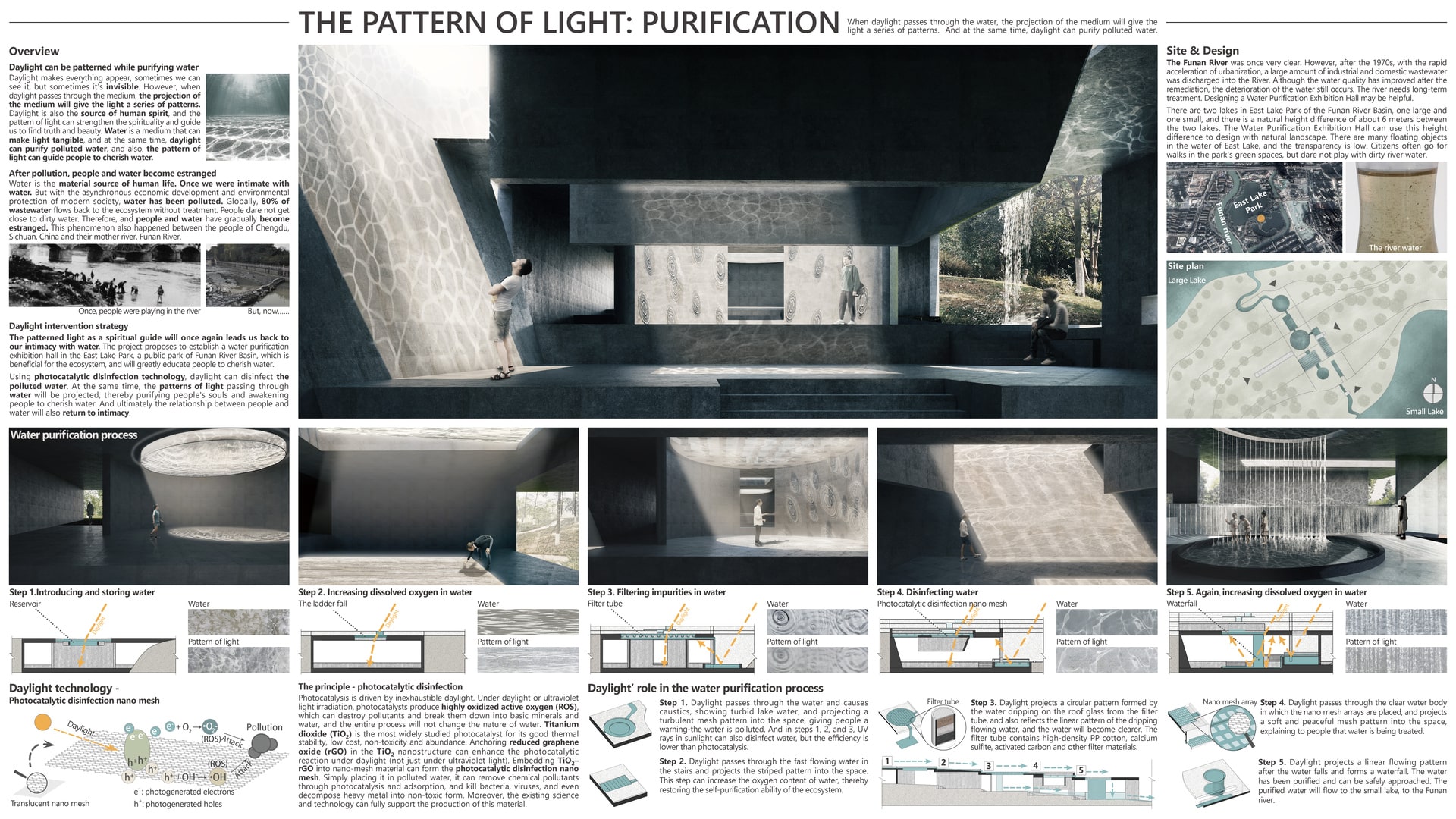Project Description
1.Overview 1.1 Daylight can be patterned while purifying water Daylight makes everything appear, sometimes we can see it, but sometimes it’s invisible. However, when daylight passes through the medium, the projection of the medium will give the light a series of patterns. Daylight is also the source of human spirit, and the pattern of light can strengthen the spirituality and guide us to find truth and beauty. Water is a medium that can make light tangible, and at the same time, daylight can purify polluted water, and also, the pattern of light can guide people to cherish water. 1.2 After pollution, people and water become estranged Water is the material source of human life. Once we were intimate with water. But with the asynchronous economic development and environmental protection of modern society, water has been polluted. Globally, 80% of wastewater flows back to the ecosystem without treatment. People dare not get close to dirty water. Therefore, and people and water have gradually become estranged. This phenomenon also happened between the people of Chengdu, Sichuan, China and their mother river, Funan River. 1.3 Daylight intervention strategy The patterned light as a spiritual guide will once again leads us back to our intimacy with water. The project proposes to establish a water purification exhibition hall in the East Lake Park, a public park of Funan River Basin, which is beneficial for the river water system, and will greatly educate people to cherish water. Using photocatalytic disinfection technology, daylight can disinfect the polluted water. At the same time, the patterns of light passing through water will be projected, thereby purifying people's souls and awakening people to cherish water. And ultimately the relationship between people and water will also return to intimacy. 2. Daylight technology - photocatalytic disinfection nano mesh 2.1 The principle - photocatalytic disinfection Photocatalysis is driven by inexhaustible daylight. Under daylight or ultraviolet light irradiation, photocatalysts produce highly oxidized active oxygen (ROS), which can destroy pollutants and break them down into basic minerals and water, and the entire process will not change the nature of water. Titanium dioxide (TiO2) is the most widely studied photocatalyst for its good thermal stability, low cost, non-toxicity and abundance. Anchoring reduced graphene oxide (rGO) in the TiO2 nanostructure can enhance the photocatalytic reaction under daylight (not just under ultraviolet light). Embedding TiO2–rGO into nano-mesh material can form the photocatalytic disinfection nano mesh. Simply placing it in polluted water, it can remove chemical pollutants, and kill bacteria, viruses, and even decompose heavy metal into non-toxic form. Moreover, the existing science and technology can fully support the production of this material. 3.Site & Design The Funan River was once very clear. However, after the 1970s, with the rapid acceleration of urbanization, a large amount of industrial and domestic wastewater was discharged into the River. Although the water quality has improved after the remediation, the deterioration of the water still occurs. The river needs long-term treatment. Designing a Water Purification Exhibition Hall may be helpful. There are two lakes in East Lake Park of the Funan River Basin, one large and one small, and there is a natural height difference of about 6 meters between the two lakes. The Water Purification Exhibition Hall can use this height difference to design with natural landscape. There are many floating objects in the water of East Lake, and the transparency is low. Citizens often go for walks in the park's green spaces, but dare not play with dirty water. 4. Daylight‘role in the water purification process Step 1. Daylight passes through the water and causes caustics, showing turbid lake water, and projecting a turbulent mesh pattern into the space, giving people a warning-the water is polluted. And in steps 1, 2, and 3, UV rays in sunlight can also disinfect water, but the efficiency is lower than photocatalysis. Step 2. Daylight passes through the fast flowing water in the stairs and projects the striped pattern into the space. This step can increase the oxygen content of water, thereby restoring the self-purification ability of the ecosystem. Step 3. Daylight projects a circular pattern formed by the water dripping on the roof glass from the filter tube, and the water will become clearer. The filter tube contains high-density PP cotton, calcium sulfite, activated carbon and other filter materials. Step 4. Daylight passes through the clear water body in which the nano mesh arrays are placed, and projects a soft and peaceful mesh pattern into the space, explaining to people that water is being treated. Step 5. Daylight projects a linear flowing pattern after the water falls and forms waterfall. The water has been purified and can be safely approached. The purified water will flow to the small lake, to the Funan river.
